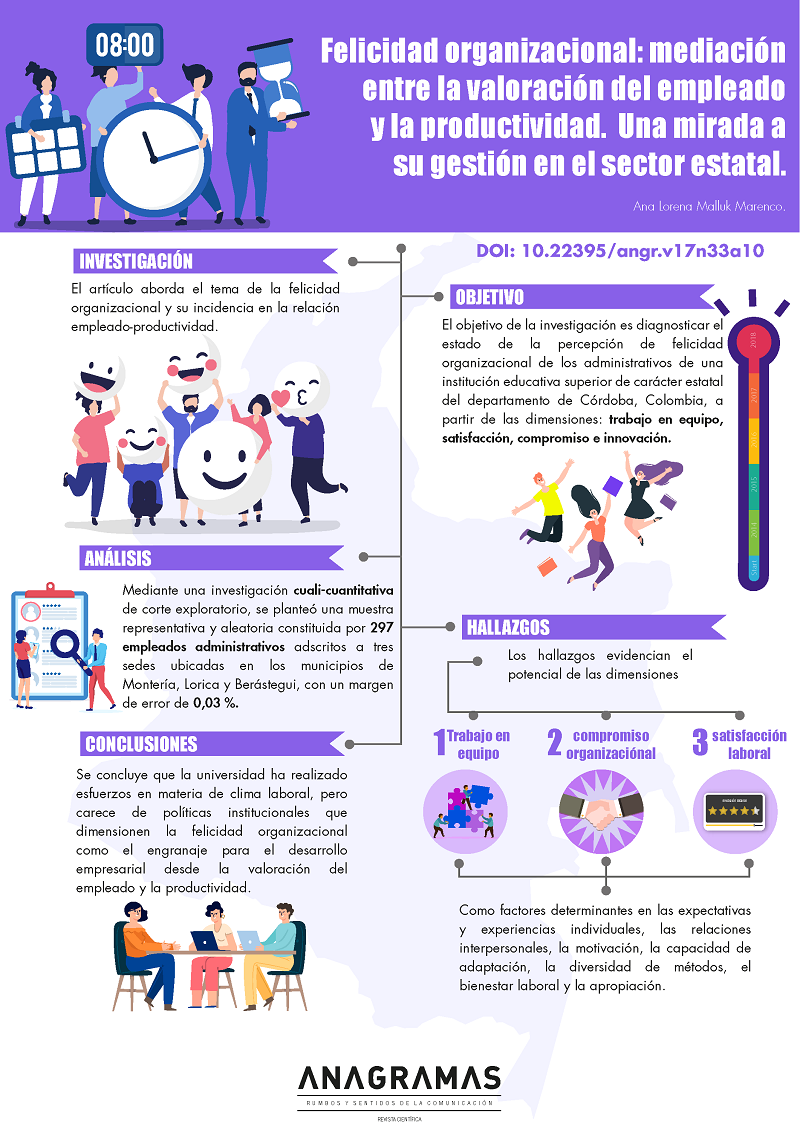Organizational happiness: mediation between employee valuation and productivity. A look at its management in the state sector
Main Article Content
Abstract
This paper addresses the issue of organizational happiness and its impact on the employee-productivity relationship. The goal of the research was to diagnose the state of the perception of organizational happiness of the administrative personnel of a public higher education institution Department of Córdoba (Colombia), relying on four dimensions: Teamwork, satisfaction, commitment, and innovation. Through a qualitative-quantitative and exploratory research, a representative and random sample comprised by 297 administrative employees assigned to three offices located in the municipalities of Montería, Lorica and Berástegui, with a margin of error of 0.03%, was analyzed. The findings show the potential of the teamwork and commitment dimensions to the organization / function, and the need to strengthen job satisfaction and innovation as determining factors in individual expectations and experiences, interpersonal relationships, motivation, adaptability, diversity of methods, work well-being, and appropriation.
It is concluded that the university –distinguished by being traditional and influential, with a complex structure, a number of employees that exceeds six hundred people, and subject to surveillance by the State– has made efforts in matters of work climate, but lacks institutional policies that measure organizational happiness as the gear for business development based on employee assessment and productivity.
Article Details
References
Baker, W. y Sinkula, J. (1999). Learning orientation, market orientation, and innovation: integrating and extending models of organizational performance (Vol. 27). Boston: Journal of the Academy of Marketing Science.
Betancourt, A. (1985). Organizaciones y administración: un enfoque de sistemas. Cali: Norma.
Carballeira, M. González, J. Marrero, R. (2015). Diferencias transculturales en bienestar subjetivo: México y España. Anales de Psicología, 31(1), 199-206. https://doi.org/10.6018/analesps.31.1.166931
Cardona, C. (2002). Fundamentos de administración. Bogotá: ECOE.
Dankhe, G. (1986). Investigación y comunicación. En C. Fernández-Collado y G.L. Dankhe (Eds.), La comunicación humana: ciencia social (pp. 385-454). Ciudad de México: Mc.Graw-Hill.
Drucker, P. (1993). La sociedad poscapitalista. Buenos Aires: Sudamericana.
Dutschke, G. (2013). Factores condicionantes de felicidad organizacional. Estudio exploratorio de la realidad en Portugal. Revista de Estudios Empresariales, (1), 21–43.
Fernández, I. (2015). Felicidad organizacional: cómo construir felicidad en el trabajo. Santiago de Chile: Ediciones B.
Fisher, C. (2010). Happiness at Work. International Journal of Management Reviews, 12(4), 384-412.
Gutiérrez, M. y Gonçalves, T. (2013). Activos para el desarrollo, ajuste escolar y bienestar subjetivo de los adolescentes. International Journal of Psychology and Psychological Therapy, 13(3), 339-355.
Hernández Sampieri, R., Fernández, C. y Baptista, P. (2006). Metodología de la Investigación (4ª ed.). México: McGraw-Hill.
Hosie, P., Cooper, C. y Sevastos, P. (2007). The Happy Productive Worker Thesis and Australian Managers. Journal of Human Values 13(2), 151-176.
Malluk, A. y Bedoya, S. (2016). Diagnóstico de comunicación organizacional de la institución educativa Cristobal Colón de Montería,(tesis de pregrado) Universidad Pontificia Bolivariana, Monteria, Colombia.
Nader, M. Castro, A. (2010). Teorías implícitas del liderazgo, LMX y bienestar laboral: generalización de un modelo teórico. Revista de Psicología, 28(2), 227-258.
Meyer, J. y Allen, N. (1984). Testing the side-bet theory of organization commitment: Some methodological considerations. Journal of Applied Psychology, 69(3), 372-378.
Gamboa, E. (2006). Satisfacción laboral: descripción teórica de sus determinantes. Recuperado de http://www.psicologiacientifica.com/satisfaccion-laboral-determinantes
Oberle, E., Schonert-Reichl, K. y Zumbo, B. (2011). Life satisfaction in early adolescence: Personal, neighborhood, school, family, and peer influences. Journal of Youth and Adolescence, 40(7), 889-901.
Corral, S. y Pereña, J. (2003). Cuestionario de Clima Laboral (CLA): test para evaluar el clima laboral de las empresas y las organizaciones. Madrid: TEA.
Pulido, F. y Herrera, F. (2018). Predictores de la felicidad y la inteligencia emocional en la educación secundaria. Revista Colombiana de Psicología, 27(1), 71-84. https://doi.org/10.15446/rcp.v27n1.62705
Quiceno, J. y Vinaccia, S. (2015). Calidad de vida, fortalezas personales, depresión y estrés en adolescentes según sexo y estrato. International Journal of Psychology and Psychological Therapy, 14(2), 155-170.
Revista Líderes. (2014). Las empresas miran en la felicidad un nuevo indicador. Recuperado de https://www.revistalideres.ec/lideres/empresas-miran-felicidad-nuevo-indicador.html
Rodríguez, M. (2010). Métodos de investigación: diseño de proyectos y desarrollo de tesis en ciencias administrativas, organizacionales y sociales. México: Universidad AutoÌnoma de Sinaloa.
Caycho Rodríguez, C. (2010). Variables psicológicas asociadas con la felicidad en centros periurbanos y urbanos marginales de Lima. UCV-Scientia, 2(1), 61-68
Rodríguez, C. y Caño, A. (2012). Autoestima en la adolescencia: análisis y estrategias de intervención. International Journal of Psychology and Psychological Therapy, 12(3), 389-403.
Salanova, M., Martínez, I. y Llorens, S. (2005). Psicología organizacional positiva. en F. Palací (Coord.), Psicología de la organización (pp. 349-376). Madrid: Prentice-Hall.
Salanova, M. Martínez, I. Llorens, S. (2014). Una mirada más 'positiva' a la salud ocupacional desde la Psicología Organizacional Positiva en tiempos de crisis: aportaciones desde el equipo de investigación WONT. Papeles del Psicólogo, 35(1), 22-30.
Salessi, S. y Omar, A. (2017). Satisfacción laboral: un modelo explicativo basado en variables disposicionales. Revista Colombiana de Psicología, 26(2), 329-345. doi: 10.15446/rcp.v26n2.60651
Särndal, C. Swensson, B. y Wretman, J. (2003). Model assisted survey sampling. Nueva York: Springer Science & Business Media.
Seligman, M. (1999). The president´s address. American Psychologist, 54, 559-562.
Seligman, M. y Csikszentmihalyi, M. (2000). Positive psychology: An introduction. American Psychologist, 55, 5-14.
Shona, L. Brown, M. Eisenhardt, K. (1997). The Art of Continuous Change: Linking Complexity Theory and Time-Paced Evolution in Relentlessly Shifting Organizations (Vol. 42). Boston: Administrative Science Quarterly.
Stake, R. (2007). Investigación con estudio de casos (4ª ed.). Madrid: Morata.
Tarragona, M. (2013). Psicología Positiva y Terapias Constructivas: Una Propuesta Integradora. Terapia Psicológica, 31(1), 115125.
Oswald, A., Proto, E. y Sgroi, D. (2015) Happiness and productivity. Journal of Labor Economics, 33(4), 789-822.
Yin, R. (1993). Applications of Case Study Research (Applied Social Research Methods Series, Vol. 34). Washington: Cosmos Corporation.





